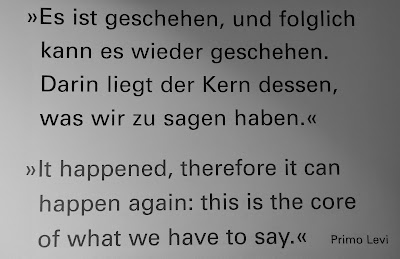Long after I have forgotten many of the things we saw on our trip to Berlin, the overwhelming impression left on me by the 'Memorial to the murdered Jews of Europe" will remain. In the heart of Berlin, a stone's throw from the Brandenburg Gate, and the Reichstag over 2,700 concrete blocks, "Stelae" project up from the ground in rows. At a distance the Stelae all look alike - faceless and anonymous; but in fact each is unique. They all vary in size, weight, dimensions, and angle. This, quite remarkably I think, represents the way in which the vast scale of evil weighed in terms of millions of deaths can anonymise the victims and paint them as uniform. This must be challenged, as this is the lie of the perpetrators of these crimes. The stelae do not let such things go unanswered however, because when the visitor actually walks amongst them and sees, and touches their uniqueness; the vast figure of 6million is hidden behind the view of individual tragedies. And each one is unique, and valuable. The great and the good, the rich and poor, the old and the young, the fat and the thin.
Amongst the stelae there is a silence, a deep mournful silence. As we walked in amongst them, Berlin was bathed in a gentle rain, of fine misty droplets, which clung to the stalae. Miriam Brysk's work on the Holocaust is called "The Stones Weep". I don't know if the designers of this memorial had her words in mind as they built their solemn structures; but these slabs were weeping the morning we were there.
They didn't weep great gushing tears of anguish, like those which are the accompaniment to great shock or sudden trauma; rather the tears gently and consistently welled on the slabs, as if they had wept for a long time and would weep forever.
Underneath the ground in the information centre, the stelae continue, as coffin shaped indentations on the ceiling, or as great slabs hanging down from it. On these subterranean columns, the stories of the murdered, and their murdered communities are told. The first-hand accounts of what happened to the Jews of Europe are appalling. It is a place where everyone reads and no one speaks.
This is an important place. There are two great dangers which remembering the evil of the 1930s and 40s faces; glorification and denial. Tragically, there are still those in the world today who would wish to honour and imitate this great wickedness - and they must be given no opportunity. On the other hand there are those who would wish to deny these events, and erase them from public memory, and they must be confronted with the truth in memorials. With its focus on the victims, this place presents no opportunities for the misuse of this history, but deeply and powerfully speaks the truth about what occurred. In the entrance to the information centre, which contains the names of every known Jewish victim of Nazi terror, these words are written:
This is why the memorial is so important. Humanity has sunk this low before, and so has the propensity to do so again.







No comments:
Post a Comment